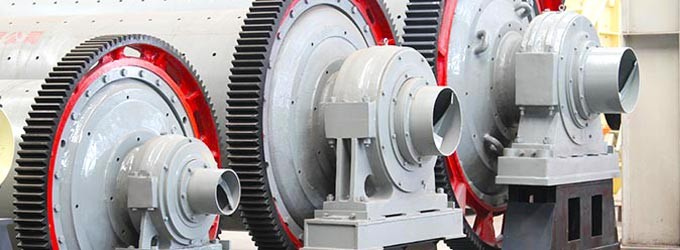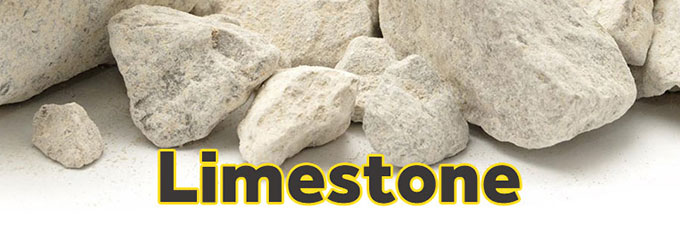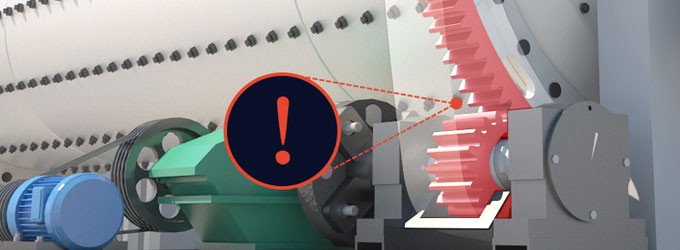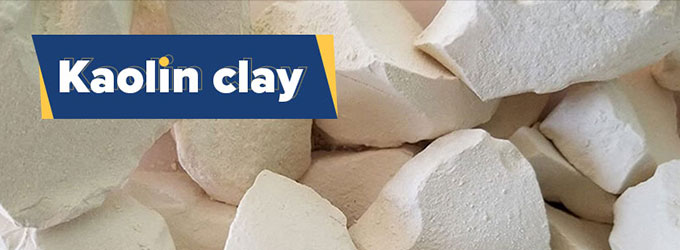Ball mills and rod mills can grind a variety of mining materials and are common grinding equipment in the beneficiation process. To obtain higher grinding efficiency, it is necessary to select a suitable mill.
Similarities between ball mill and rod mill:
- Appearance: Horizontal cylindrical structure.
- Components: Equipped with grinding media, feeders, gears, and transmissions.
- Working principle: The cylinder drives the grinding media to move, making them impact and grind the material.
What are the differences between the two devices that are so similar? How to select suitable equipment? Please find the answer in this blog.
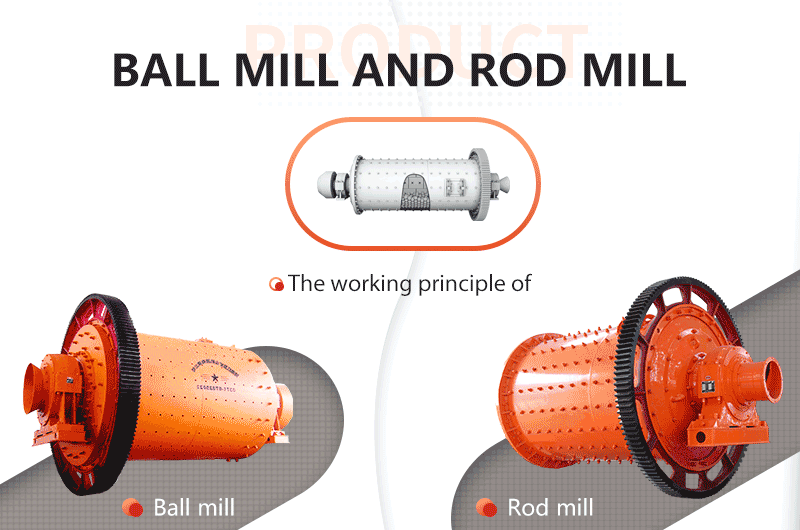
Ball mill and rod mill
Differences between ball mill and rod mill
1. Different capacity and granularity
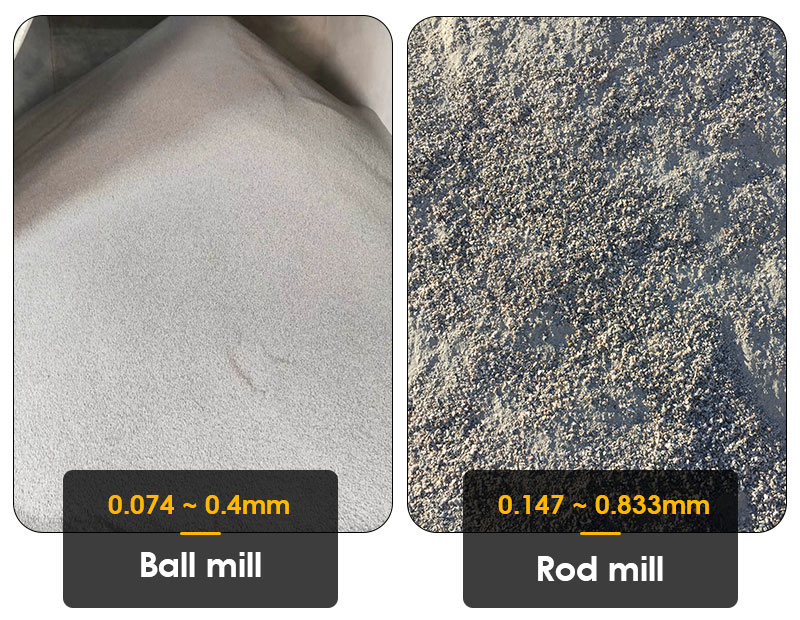
Ball mill
The capacity of ball mills is 0.65 ~ 615t/h, and the discharge particle size of the ground material is 0.074 ~ 0.4mm.
Rod mill
The capacity of rod mills is 0.62 ~ 180t/h, and the discharge particle size is 0.147 ~ 0.833mm.
2. Different grinding media
Ball mill
Ball mills use steel balls with a diameter of less than 100mm as the grinding media, and the medium filling rate is 40% to 50%.
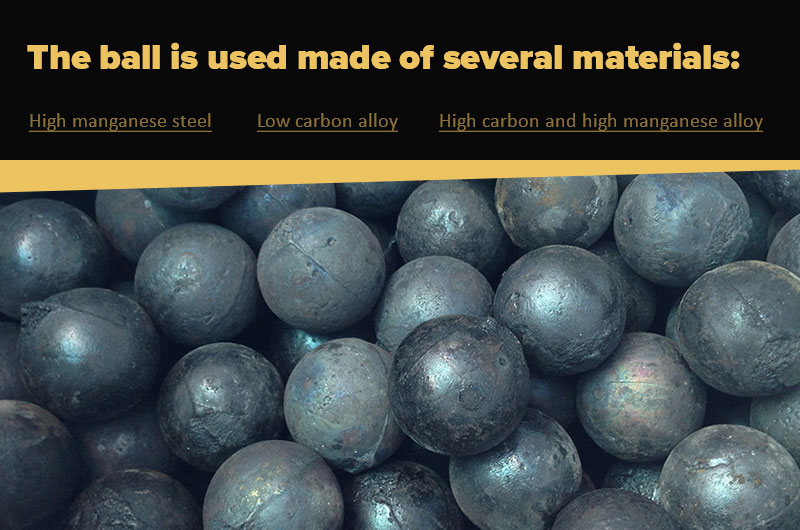
Steel balls are mainly made of several materials:
-
1High manganese steel
High manganese steel has high toughness, good manufacturability, and low price. The harder index is 5 ~ 7 times higher than other materials, and the wear resistance is greatly improved.
-
2Low carbon alloy
Under the condition of good toughness and low price, the service life is more than twice that of low chromium cast ball.
-
3High carbon and high manganese alloy
It is made of several elements such as chromium and molybdenum, which has high hardness and good toughness. Under the same work condition, the service of this kind of ball is one time longer than the high manganese steel ball.
Rod mill
Rod mills use steel rods with a carbon content of 0.8% ~ 1% and a diameter of 50 ~ 100 mm as the grinding media, and the medium filling rate is 35% ~ 45%.

Steel rods are mainly made of several materials:
-
1High carbon steel
After the professional technology straightening and quenching processing process, a high carbon steel rod has high hardness, excellent performance, good wear resistance, and outstanding quality.
-
242CrMo steel
42CrMo steel material is high strength steel. Improved based on 40Cr steel, the wear resistance is about 1.3~1.5 times that of 40Cr, but the price is only 1.1 times that of 40Cr.
3. Different types
Ball mill
According to the discharging way, ball mills can be divided into two types: grate discharge type and overflow type.
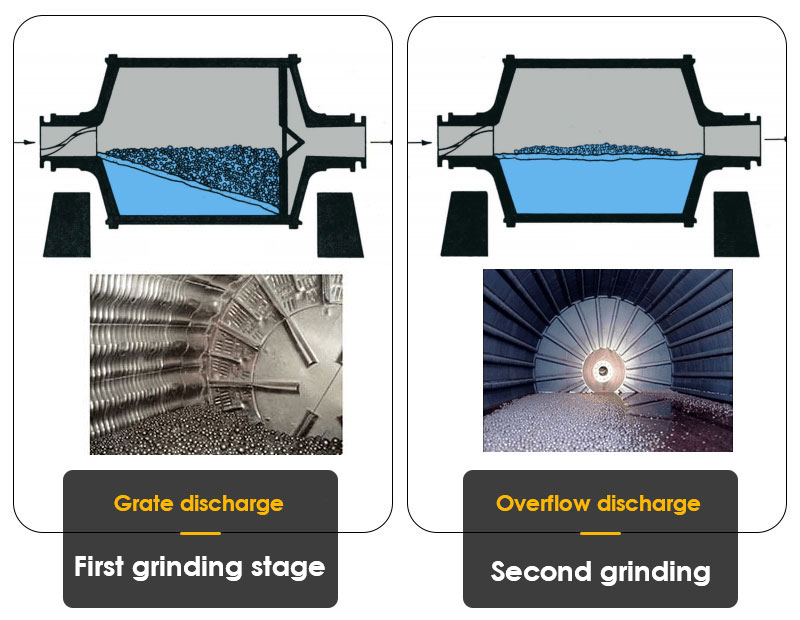
a. Grate discharge ball mill
The grate discharge ball mill can discharge material through a sieve plate, with the advantage of the low height of the discharge port, which can make the material pass quickly. Under the same condition, it has a higher capacity and can save more energy than other types of mills.
The product has a coarser particle size and is usually used in the first grinding stage. It is better to select a grate discharge ball mill when the required discharge size is 0.2 ~ 0.3 mm.
b. Overflow discharge ball mill
The overflow discharge ball mill is designed with no sieve plate so that the ore pulp can be discharged directly without filtration. It is very simple in structure and convenient for maintenance.
Overflow type can grind ores into the size under 0.2 mm, so it is very suitable for the second grinding system. The capacity is about 15% lower than that of the grate discharge ball mill of the same specification, and the grinding media loaded is also less.
Rod mill
According to the discharging way, rod mills can be divided into three types: center and side discharge type, end and side discharge type, and overflow type.
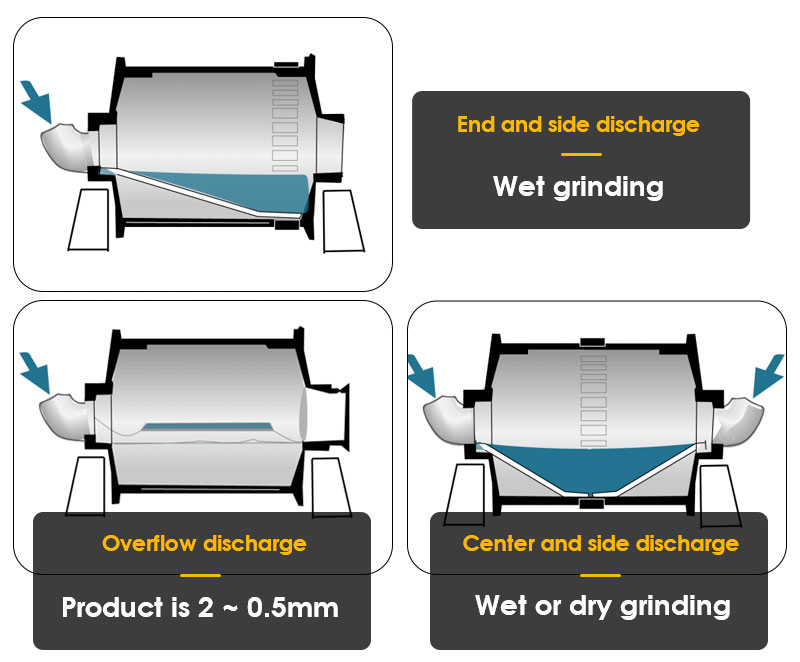
a. End and side discharge rod mill
This kind of rod mill is generally used for dry grinding, and the product particle size is relatively coarse. It can also be used for wet grinding. A high gradient and good flow rate can be obtained with peripheral discharge, and the product particle size is 5 ~ 2 mm.
b. Center and side discharge rod mill
It is fed through the shaft necks in the two ends of the rod mill and discharges ore pulp through the port in the center of the cylinder. This rod mill can be used for wet or dry grinding, but the product has a coarser particle size and is mainly used in the aggregate industry.
c. Overflow discharge rod mill
It is fed through one of the shaft necks and discharges materials through the other shaft neck. The diameter of the shaft neck is larger than the diameter of the feeding port about 10 ~ 20 centimeters so that the height difference can form a gradient for ore pulp flow.
The particle size of the product is finer than the other two, and the particle size of the product is 2 ~ 0.5mm. It is generally used to grind products and then supply them to ball mills.
4. Different cylinder proportions
Although ball mills and rod mills are both long and cylindrical, their cylindrical ratios are different.
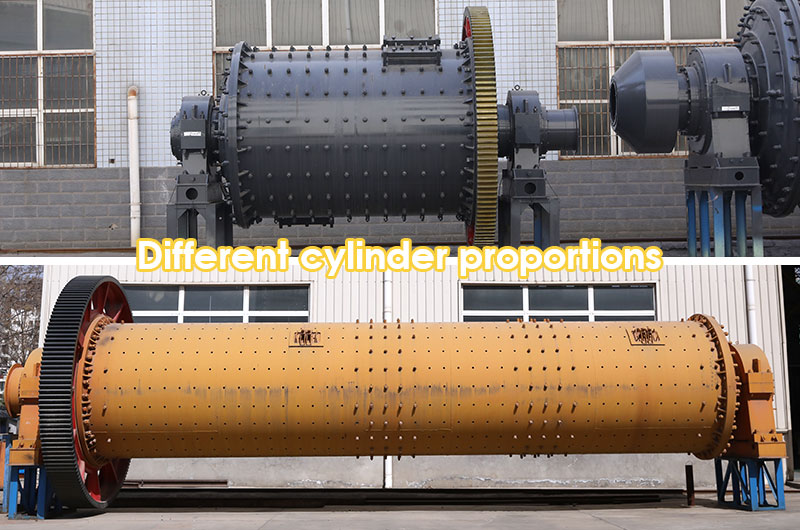
Ball mill
The cylinder length to diameter ratio of ball mills is small, usually around 1. The rotating speed of the cylinder of the ball mill is generally higher than that of the rod mill of the same specification.
Rod mill
The cylinder length to diameter ratio of rod mills is generally between 1.5 ~ 2.0, and the inner surface of the lining plate on the end cover is in a vertical plane state.
5. Different equipment performance
Ball mill
The grinding medium of the ball mill is in point contact with the ore, which has both impact force and grinding force. The production capacity is high, and the fineness of the material is high.
Rod mill
The grinding medium of the rod mill is in linear contact with the ore. Most of the coarse particles are ground first, and a small part of the fine particles are ground. The product is rough.
Advantages and disadvantages of ball mill and rod mill
1. Ball mill Get Latest Price

Advantages:
- It has strong adaptability to materials and can be made into different sizes of mills to meet the requirements of various production capacities.
- Large crushing ratio, easy to adjust product fineness, and finer product particle size.
- Adopt larger size rolling bearings, resulting in low friction, low energy consumption, and a short start-up time of the mill.
- Ball mill has no inertia impact, which ensures the efficient operation of the equipment and reduces the downtime of the equipment.
Disadvantages:
- The ball mill grinds fine materials and is prone to excessive crushing.
- Due to the fine size of the output material, it is not suitable for metal beneficiation and gravity separation production lines.
2. Rod mill Get Latest Price
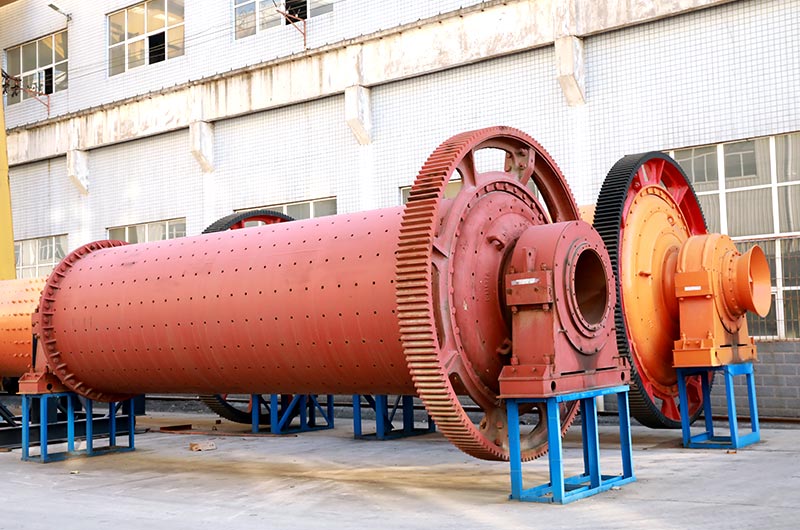
Advantages:
- Product with uniform particle size, lighter crushing, and less grit and slime.
- Good sealing, avoiding dust and noise pollution to the environment, green and environmental protection.
- Simple configuration and low cost, which can save investment in dust removal equipment.
- The energy consumption of the equipment is low, saving users a lot of expenses.
Disadvantages:
- Rod mill products are rough and are mostly used for rough grinding of ore, which is the first stage of grinding.
How to select a ball mill or rod mill?
After fully understanding the differences between ball mill and rod mill, it also lays the foundation for purchasing equipment and you can choose from the following:
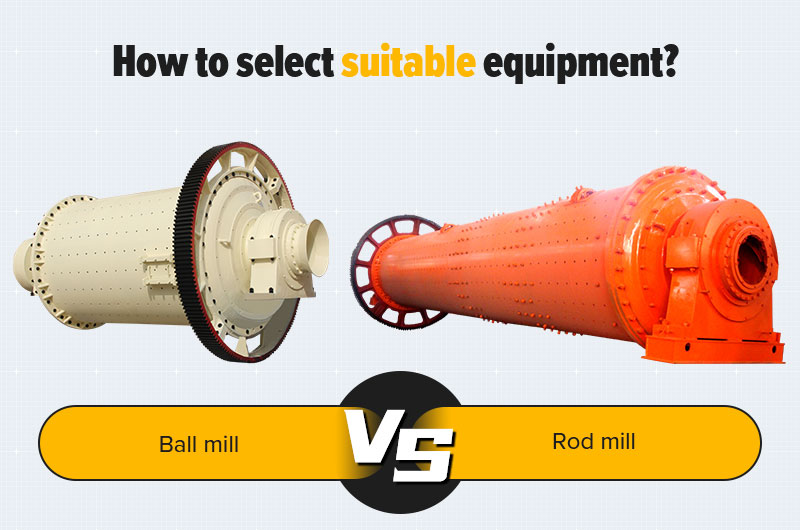
1. By raw material
Select a ball mill
Ball mill is suitable for grinding hard materials, such as iron ore, copper ore, slag, etc. If the grinding materials are molybdenum ore, aluminum ash, lime, cement, etc. the processing capacity of the ball mill is stronger.
Select a rod mill
Rod mill is suitable for grinding brittle materials, commonly used in materials such as tungsten ore, tin ore, rare metal ore, and coal.
2. By the granularity of finished products
Select a ball mill
The fineness of the finished product of the ball mill is high. When the particle size of the product is less than 0.5mm, it is recommended to use a ball mill.
Select a rod mill
The product of the rod mill is rough, but the quality of the finished product is uniform. When the product particle size is 1~3mm, it is recommended to use a rod mill.
3. By the work site
In the design of the dressing plant, the floor plan of the grinding workshop is usually designed in advance, so it is necessary to consider the floor space of the equipment.
Select a ball mill
The shape of the ball mill is cylindrical. The length diameter ratio of the cylinder is very small, and the floor area is small.
Select a rod mill
The cylinder of the rod mill is long, with a large length diameter ratio and large floor area. Therefore, whether the equipment installation conditions can be met should be considered in the selection.
Applications of ball mill and rod mill
1. Ball mill
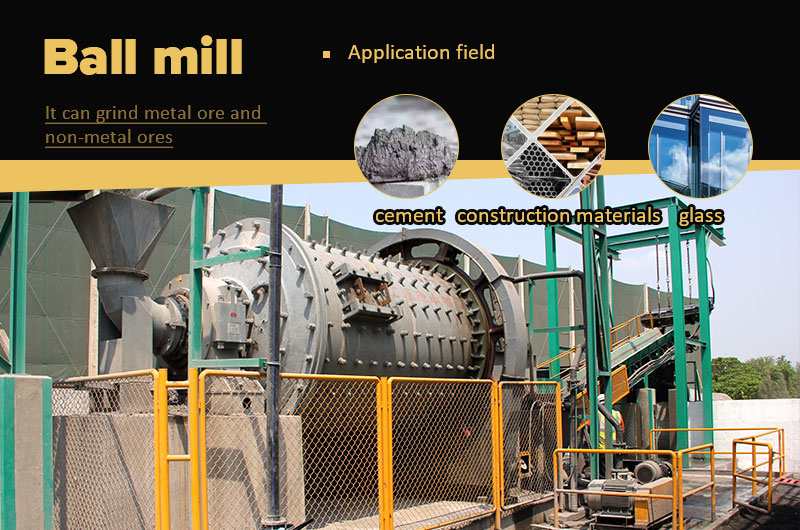
- aBall mill has a wide range of applications. It can grind metal ore and non-metal ores, which is suitable for hard materials, such as quartz, gold ore, copper ore, iron ore, potash feldspar, etc.
- bBall mill is also can be applied in the industries such as cement, construction materials, fireproofing materials, glass, and ceramics. And the fineness of the finished product can reach 800 meshes.
2. Rod mill
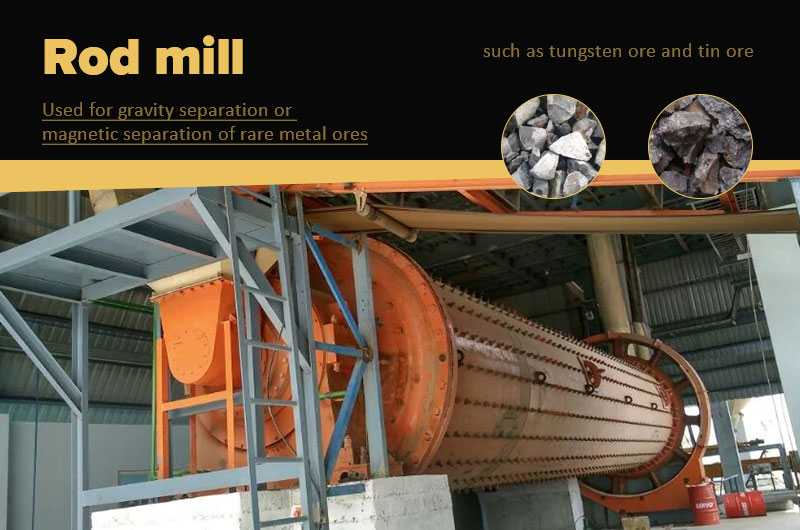
- aRod mill is often used for gravity separation or magnetic separation of rare metal ores such as tungsten ore and tin ore to prevent excessive crushing.
- bRod mill is also suitable for crushing low hardness and brittle materials, as fine crushing equipment, instead of a short-head cone crusher.
- cIn the two-stage grinding process, the rod mill is generally used as the first grinding equipment, with large production capacity and high efficiency.
To sum up, although both ball mills and rod mills are grinding machines, there are still big differences internally. They have their own advantages, so it is very necessary to select the right machine for the production line of different materials, to maximize its efficiency and optimize product results.
Contact us for a Free Sample Testing!


